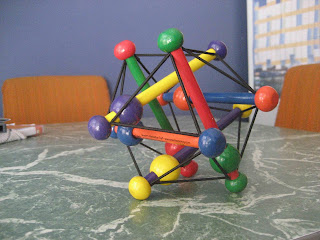Tensegrity
 This is a tensegrity toy. Babies love them, because they make cute noises and spring back into their original shape no matter how often and where you squash them.
This is a tensegrity toy. Babies love them, because they make cute noises and spring back into their original shape no matter how often and where you squash them.Tensegrity may turn out to be one of the most important ideas ever created. Tensegrity is what's called a portmanteau word, comprised of two words and their meaning contracted into one (in this case 'tensional' and 'integrity'). So in other words, a tensegrity structure gets its structural integrity from tension - it's the tensional elements that make the whole thing hold together.
So if you look at the picture of the toy, you'll see black elastic string. The only other parts to the toy (apart from the sliding beads, which make the nice noises) are the wooden, coloured rods, which stretch the string out in various directions. They're 'compression' elements - they 'push' while the elastic string 'pulls'. There's only the one string, which creates a sort of web of elastic inside which the rods sit, so that the rods push out into the web and create a shape that remains the same and returns to this same shape, no matter how many times and ways you squash the toy.
This is very different to traditional structures, where compression elements like columns and walls tend to hold things up, and you get tensions in various places e.g. a beam sat upon two columns horizontally will have tension within it due to the unbalanced force of gravity acting along its length between the vertical columns. So in a traditional structure you have tensions and compressions, or pushes and pulls, but the pushes are dominant, and overall while the structure will be 'balanced' in that it doesn't (hopefully) fall over, some parts of the structure will be carrying a lot more of any load than other parts.
In a tensegrity structure all of the forces are spread evenly over the entire web. So if you squash the toy, all of the force you apply will be distributed by the elastic pulls over the entire toy evenly, and it collapses all as one thing and then rebounds all as one thing. A tensegrity structure therefore balances tension and compression (pushes and pulls) perfectly, and everywhere within the structure. There are no stresses and strains. What's more the structure is stable in every orientation - for example you can turn it upside down, sideways, or whatever, and it will remain as it is. Try that with a building or other structure!
Another way to look at this is to say that tensegrity is what makes a nonsense of the undertstanding of gravity as being that thing which made the apple fall on Newton's head. Some force which inexorably drags everything downwards, from planes to apples, to just us standing here on the ground. A tensegrity structure perfectly balances pushes and pulls and just is. It just sits there, poised, not falling down and not rising up, with no strains. The rods in the toy are suspended in space and therefore seem to defy gravity, but there's no straining going on to allow that to happen - tensegrity weaves gravity into structures and shapes, so that it acts in every direction at once, not just down.
It won't surprise you that, given the previous LearningMethods posts, the body is now thought to be a tensegrity structure. It's all there - the effortlessness is the spreading of your forces of sitting or walking (or whatever) evenly across your entire body, which has bones as the wooden rods and muscles and all of its tissues as the elastic string. You're actually suspended in mid-air by this elastic web of tissue, which then springs you off into movement, or supports you completely and effortlessly as you stand or sit. But it gets even more interesting, because every part of your body, right down to the cells in every organ and even at lower scales than that, is a tensegrity structure. Cells have exactly this sort of springy tensegrity structure, and change what they turn into depending upon the forces you put upon them.
The implications of this are huge, and have some enlightened researchers working very busily every day. Donald Ingber at Harvard was one of the pioneers in this area, and he notes that the structure of matter itself may be a tensegrity system, with our universe made up of compression elements (like black holes) and tension elements (space itself) woven together in a precise balance. But for now you can just play with the idea of your body being this effortless, elastic web in space, and see where it takes you. Or go and take one of David's workshops, or buy a recording from his website. You'll never regret it.


Comments
Post a Comment